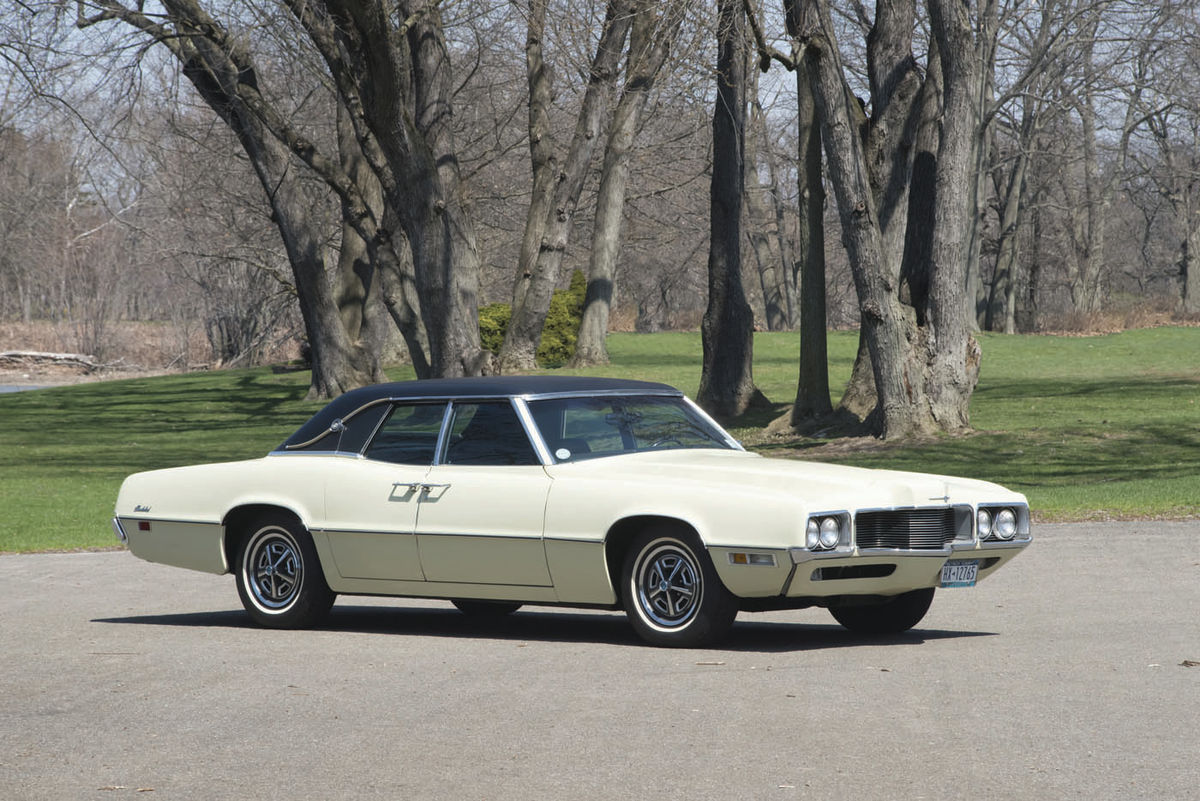1970 Thunderbird landau
The Thunderbird Started as a TwoDoor Sports Car and Grew Into a Four-Door Sedan. This Collector Was Immediately Drawn to the Four-Door Look.
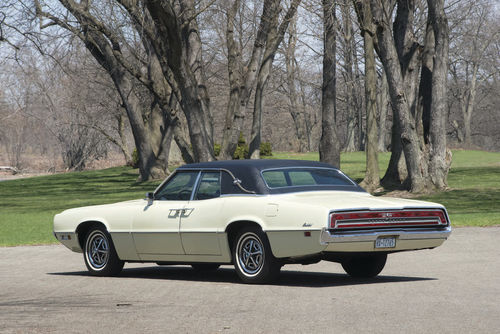
While Thunderbirds have appeared in forms ranging from supercharged open twoseaters to turbocharged coupes, some owners hold a deep appreciation for a version that might not come as quickly to mind.
“When they were first introduced in ’67, they caught my eye and my love,” explained Mike Murray, whose is featured here, “and at that point in time, I said ‘someday, I’m going to own a four-door Thunderbird.’”
The idea of a four-door Thunderbird was at least moderately surprising at that time and the fact that its rear doors opened at the B-pillar would have been utterly shocking if Lincolns hadn’t been offering suicide doors since 1961. By then, of course, the Thunderbird had already produced its share of the unexpected and even the car itself would have been unthinkable just 15 or 20 years before its 1955 introduction.
Heading In New Directions
American automakers had offered radical and flamboyant models on a limited scale before World War II— think, for example, Chrysler Airflow— but it would be a stretch to claim that they were the direct ancestors of what would later be known as “personal luxury cars.” Similarly, the mid- to late-1930s saw the slow rise of woodies as status symbols since they hinted that someone driving a station wagon probably had a better car, too, but few woodies could lay claim to being anything like a personal luxury car until Chrysler introduced its Town and Country for 1941. The Town and Country took a fresh approach with rounded rear styling that gave it a sedan look and the nickname, “barrelback.” It was stylish, at least somewhat exclusive and clearly not designed as a working man’s station wagon.
The Town and Country returned for 1942 and then disappeared midway through the model year when World War II stopped the flow of civilian vehicles, but it was an idea too good to abandon and so it returned for 1946. Convertibles, four-door sedans and a handful of coupes were built, all obvious derivatives of the original and even more stylish. With the wagon having been dropped, it was now impossible to overlook the Town and Country’s placement in an upscale market.
A Town and Country convertible was offered in 1949 and a twodoor hardtop was the sole model in 1950, but woodies of any kind were doomed. In terms of practicality, just about everything was wrong as the cars were costly, demanded maintenance and were difficult and expensive to repair.
By 1954, American production woodies were gone, but something very different was underway among the Big Three. Cadillac and Oldsmobile had introduced modern, short-stroke V-8s in 1949 as Buick launched the Riviera two-door hardtop. The new engine design and new body style soon became industry standards, but Chevrolet struck out on its own when it displayed the Corvette show car at the January 1953 GM Motorama.
American Sports Cars
The fiberglass-bodied Corvette used a short 102-inch wheelbase, seated only two, lacked door handles and side windows, was notably low and wore sports-car-like screened headlights. Combined with a 150-horsepower version of Chevy’s overhead-valve six and a two-speed automatic, it was fine for a show car and must have seemed both exotic and impossible to sell as a production car, but that last part changed almost instantly when the public responded. Conventional wisdom was discarded, Chevrolet began advertising the Corvette’s upcoming availability and the first production example was completed at the end of June. It was almost identical to the show car, as were the 1954 Corvettes that followed and unfortunately for Chevy’s chief rival, there was no Ford model ready to provide competition.
However, Ford’s threat did appear soon enough when “a new high-spirited personal car that’s at home on boulevard or open road” appeared for 1955 as the Thunderbird.
The Ford two-seater matched the Corvette’s wheelbase, but just one brochure cited enough differences to show that Ford had its own ideas as to what “a personal car of distinction” should be. It pointed to the “all-steel body…recessed, push-button door handles…the steering wheel (that) telescopes a full 3 inches…a 4-way power-operated seat…full-size safetyglass windows that can be rolled up in a ‘jiffy.’” The engine it described only as the “Y-block V-8” was the 292 with 193 horsepower or 198 in cars with automatics, an important fact since Corvettes were still offered only with automatics while Thunderbirds could be ordered with automatics, three-speed manuals or three-speed overdrives. Less important—but worth mentioning—was the fact that the 292 was the Thunderbird’s only engine choice. The Corvette had finally gotten a V-8, the 195-horsepower 265, but a six was still available.
Then the Thunderbird Grew
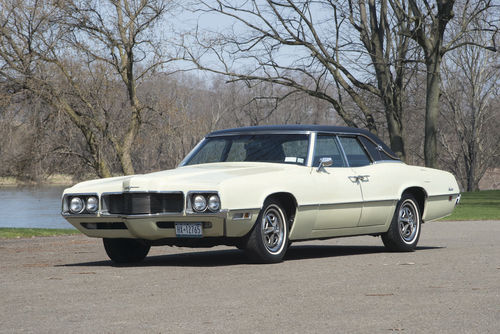
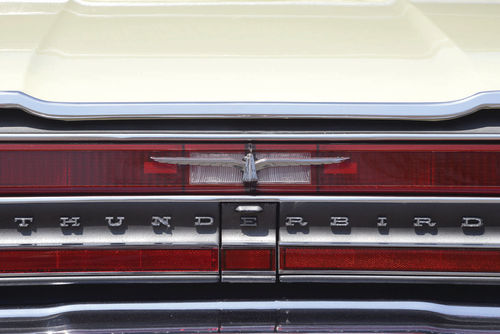
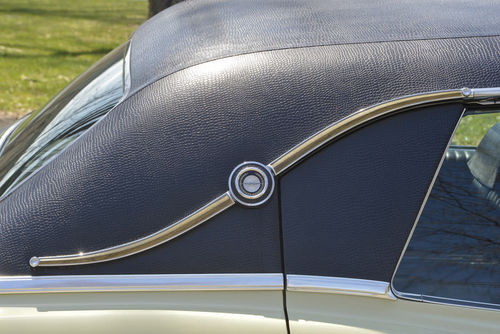
The two American sports cars coexisted for three model years before change came and Ford announced “the new four-passenger Thunderbird” for 1958. That it was “America’s most individual car” is an ad claim that wasn’t completely farfetched and evolution continued as a completely restyled Thunderbird arrived for 1961.
The new Thunderbird was clean with a horizontally pointed nose and large round taillights for an aero look, yet Ford was able to give it a roof design seemingly lifted intact from the much more angular 1958-60 Squarebird and make it work.
Meanwhile, Oldsmobile and Pontiac were taking a different approach to personal luxury cars with the 1961 Starfire and 1962 Grand Prix, optioned versions of their divisions’ full-size models. Buick followed in 1963 with its Riviera, a totally new model along the lines of what Ford had done, but when Thunderbird’s next generation arrived for 1964, advertising explained that “the look is new—yet the look is so typically Thunderbird.”
The statement fit extremely well, given that the smooth rounded look was gone in favor of sculpted lines echoing those of the Squarebird. The thick-pillared roof was back with another gentle update as was the Landau; introduced in 1962. It was now touted as “a new personal car of limousine elegance…graced by padded vinyl roof and glistening ‘S’ bars. This is the formal Thunderbird.”
Now…a Four-Door Bird
Ford completed the Thunderbird’s move into the area it had been carefully approaching and advertised the totally restyled 1967 model as “a long, smooth, rich, fast four-door unmistakably, uniquely Thunderbird.” That the sedan was a huge step—and surprising in more than one way— was alluded to with the somewhat hyperbolic statement that “when Thunderbird changes, the world sees the look of the cars of tomorrow” before the brochure copy explained that it was “an historic new four-door Landau…with doors that swing wide, away from the center pillar, providing comfortable access to front and rear compartments.”
Four-doors in the mid-1960s were generally perceived as family cars, fleet cars or luxury cars. Ford was taking a risk and no doubt counting on the new Thunderbird’s acceptance as a true luxury car, but a gamble is a gamble and Ford had the nerve to take it even as competition was changing and GM was tearing into the Thunderbird’s market segment with a vengeance.
The Riviera and Grand Prix had been joined by Oldsmobile’s Toronado in 1966 and Cadillac’s Eldorado in 1967, but the four-door Landau—a “beautiful new way to make an entrance”—was the right move as sales hit 25,000, a figure that placed it about 12,000 below the twodoor Landau but almost 10,000 above the basic coupe.

In any form, though, the 1967 Thunderbird was attractive and unique thanks to smoothed lines that made it resemble its predecessor just enough to maintain continuity, hidden headlights in a protruding grille and a full-width taillight panel bowing slightly inward at center. A 1968 update made minor changes and added the federally required side marker lights as well as another first, as an ad headlined “Thunder for 5. Thunder for 6” explained that “now the Bird flies two ways. With two doors, or four. Room for five or six, with new full-width front seats.” The front bench proved a popular choice; of 22,000 four-door Landaus sold that year, more than 17,000 were so equipped.
Give Me That Four-Door Look
After another freshening for 1969, Ford gave the 1970 Thunderbird enough changes to make it stand out. The hidden headlights were gone and the straight-across grille was replaced by a sharp point protruding substantially from a slightly concave panel and trailing over the hood to the cowl. It was “the Thunderbird of Thunderbirds” and in sedan form, it offered “four doors to ultimate luxury.” Ford promised that “luxury car devotees who prefer four-door convenience” would welcome the Landau sedan since its “wide doors, Continental style, open from the center for easier, more graceful entry.”
It was, as mentioned above, the four-door design that caught Mike Murray’s eye when he first saw the sedan.
“I have nothing against two-doors,” he said, “but there are certain cars that I want as four-doors.”
With that in mind, in about 1981 he began seriously looking by checking the hobby publications and even running his own ads in newspapers serving the area around his Conklin, New York, home. The second component of that plan backfired due to upstate New York winters and the liberal application of road salt.
“One of the phone calls I got,” Murray recalled, “was from an older gentleman who had one. Talk about your bubble bursting. When I answered the phone I could tell he was elderly and he said ‘are you the one who’s looking for a four-door Thunderbird.’ I said ‘yes’ and he said ‘well, I have one.’ Immediately, I thought ‘oh my gosh, he bought this car brandnew. It’s in his garage. It’s only got 5000 miles on it. It’s like brand-new.’ I said ‘you do?’ He said ‘I certainly do, and I’ve already started the restoration on it.’
“Well, immediately, my dream started fading.’ He said ‘I put a new battery in it, I put new front tires on it and I had the frame reinforced.’ I said ‘you what?’ He said ‘I had the frame reinforced.’ I said ‘I’m terribly sorry. I wouldn’t be interested in it.’”
Understandably, it wasn’t the Thunderbird that’s shown here. Murray found an ad for the feature car in a hobby publication in the spring of 1984. It was at a Florida dealer, he said, and with 26,000 miles had come from the first owner. Fortunately, Murray’s sister lived nearby and was enlisted to find out about the Thunderbird. As soon as she gave him her report, he called the dealer.
“I said to him ‘is there any reason this car won’t come back to New York?’” Murray recalled. “‘My father would be flying down and bringing it back.’ He said ‘the only thing that bothers me is that it’s got its original tires, but if you aren’t going to haggle with me on price, I’ll put the tires on it.’ I said ‘I’d want a service, too, all the hoses and belts and everything.’”
The deal was made and his father flew to Florida, but through some misunderstandings, the tires weren’t changed. His father drove the Thunderbird to Murray’s sister’s home, arranged for her mechanic to replace the tires and service it, called Murray and with the work completed, set out for New York. Clearly, his father was a road warrior.
“He was more than willing to go,” Murray said. “He stopped to see my sister in Ocala and then got in the car and drove right straight through. He told me when he got home ‘I knew you were probably worried about it and you were anxious to get it.’ I said ‘well, I didn’t expect you to drive
It Was In Good Original Condition
The Thunderbird had no difficulty making the trip, his father fell in love with it and best of all, the misunderstanding about the tires proved to be exactly that as the dealer explained what had happened and asked how much his father had paid for the tires he purchased.
“I don’t remember now what it was,” Murray said, “but I told him and he sent me a check. I’ve bought new cars and the dealers wouldn’t do something like that. He was a wonderful man, wonderful.”
As an un-restored original, the car wasn’t perfect, but he said the only serious problem it had when it arrived had to do with its power windows. They didn’t work and he found that a starter relay had been cobbled in as a replacement for the window relay. Luckily, the wiring harness hadn’t been damaged in the process. By the time he was finished, he’d also repaired the switches, replaced three of the motors and found a new replacement glass for the driver’s window that was badly scratched after having come off of its track.
And while it wasn’t something that kept that car from being driven and enjoyed, the exhaust was new and noticeably louder than it should have been. Murray replaced it with a correct stainless steel system and admitted that he didn’t like the idea of discarding an entire exhaust system that was in excellent condition, but it had been too loud for him.
Since it’s not his only collector car, it hasn’t been on any trips of Thunderbird’s market segment with a vengeance.
The Riviera and Grand Prix had been joined by Oldsmobile’s Toronado in 1966 and Cadillac’s Eldorado in 1967, but the four-door Landau—a “beautiful new way to make an entrance”—was the right move as sales hit 25,000, a figure that placed it about 12,000 below the twodoor Landau but almost 10,000 above the basic coupe.
In any form, though, the 1967 Thunderbird was attractive and unique thanks to smoothed lines that made it resemble its predecessor just enough to maintain continuity, hidden headlights in a protruding grille and a full-width taillight panel bowing slightly inward at center. A 1968 update made minor changes and added the federally required side marker lights as well as another first, as an ad headlined “Thunder for 5. Thunder for 6” explained that “now the Bird flies two ways. With two doors, or four. Room for five or six, with new full-width front seats.” The front bench proved a popular choice; of 22,000 four-door Landaus sold that year, more than 17,000 were so equipped.
Give Me That Four-Door Look
After another freshening for 1969, Ford gave the 1970 Thunderbird enough changes to make it stand out. The hidden headlights were gone and the straight-across grille was replaced by a sharp point protruding substantially from a slightly concave panel and trailing over the hood to the cowl. It was “the Thunderbird of Thunderbirds” and in sedan form, it offered “four doors to ultimate luxury.” Ford promised that “luxury car devotees who prefer four-door convenience” would welcome the Landau sedan since its “wide doors, Continental style, open from the center for easier, more graceful entry.” It was, as mentioned above, the four-door design that caught Mike Murray’s eye when he first saw the sedan.
“I have nothing against two-doors,” he said, “but there are certain cars that I want as four-doors.”
With that in mind, in about 1981 he began seriously looking by checking the hobby publications and even running his own ads in newspapers serving the area around his Conklin, New York, home. The second component of that plan backfired due to upstate New York winters and the liberal application of road salt.
“One of the phone calls I got,” Murray recalled, “was from an older gentleman who had one. Talk about your bubble bursting. When I answered the phone I could tell he was elderly and he said ‘are you the one who’s looking for a four-door Thunderbird.’ I said ‘yes’ and he said ‘well, I have one.’ Immediately, I thought ‘oh my gosh, he bought this car brandnew. It’s in his garage. It’s only got 5000 miles on it. It’s like brand-new.’ I said ‘you do?’ He said ‘I certainly do, and I’ve already started the restoration on it.’
“Well, immediately, my dream started fading.’ He said ‘I put a new battery in it, I put new front tires on it and I had the frame reinforced.’ I said ‘you what?’ He said ‘I had the frame reinforced.’ I said ‘I’m terribly sorry. I wouldn’t be interested in it.’”
Understandably, it wasn’t the Thunderbird that’s shown here. Murray found an ad for the feature car in a hobby publication in the spring of 1984. It was at a Florida dealer, he said, and with 26,000 miles had come from the first owner. Fortunately, Murray’s sister lived nearby and was enlisted to find out about the Thunderbird. As soon as she gave him her report, he called the dealer.
“I said to him ‘is there any reason this car won’t come back to New York?’” Murray recalled. “‘My father would be flying down and bringing it back.’ He said ‘the only thing that bothers me is that it’s got its original tires, but if you aren’t going to haggle with me on price, I’ll put the tires on it.’ I said ‘I’d want a service, too, all the hoses and belts and everything.’”
The deal was made and his father flew to Florida, but through some misunderstandings, the tires weren’t changed. His father drove the Thunderbird to Murray’s sister’s home, arranged for her mechanic to replace the tires and service it, called Murray and with the work completed, set out for New York. Clearly, his father was a road warrior.
He was more than willing to go,” Murray said. “He stopped to see my sister in Ocala and then got in the car and drove right straight through. He told me when he got home ‘I knew you were probably worried about it and you were anxious to get it.’ I said ‘well, I didn’t expect you to drive straight through.’”
It Was In Good Original Condition
The Thunderbird had no difficulty making the trip, his father fell in love with it and best of all, the misunderstanding about the tires proved to be exactly that as the dealer explained what had happened and asked how much his father had paid for the tires he purchased.
“I don’t remember now what it was,” Murray said, “but I told him and he sent me a check. I’ve bought new cars and the dealers wouldn’t do something like that. He was a wonderful man, wonderful.”
As an un-restored original, the car wasn’t perfect, but he said the only serious problem it had when it arrived had to do with its power windows. They didn’t work and he found that a starter relay had been cobbled in as a replacement for the window relay. Luckily, the wiring harness hadn’t been damaged in the process. By the time he was finished, he’d also repaired the switches, replaced three of the motors and found a new replacement glass for the driver’s window that was badly scratched after having come off of its track.
And while it wasn’t something that kept that car from being driven and enjoyed, the exhaust was new and noticeably louder than it should have been. Murray replaced it with a correct stainless steel system and admitted that he didn’t like the idea of discarding an entire exhaust system that was in excellent condition, but it had been too loud for him.
Since it’s not his only collector car, it hasn’t been on any trips of more than 50 or 60 miles, but he’s driven it enough to know that it meets the expectations he had for it. He admitted to being partial to the entire run of 1967 through 1971 Thunderbirds, but singled out the feature car.
“There’s something about that car,” Murray observed, “about the way it drives and rides. You just feel so comfortable and I’m really not a bench seat person, but it’s very comfortable. I’ve always felt the buckets were more comfortable, but the car really is a nice car. It really is a very comfortable car to me and an easy-driving car.”
Public Reaction Varies
While he doesn’t drive it very often, it’s been on the road often enough that he knows the attention it attracts. Reactions, he said, depend in part on the age of those who see it.
“A younger person?” he said, “You aren’t going to find that he knows what it is, but an older person? In fact, I pulled in one day to put gas into it and some gentleman walked out of the convenience store. He said ‘golly, I forgot how big those T-birds were.’”
Not surprisingly, he clearly recalls the time he was told that “it was the ugliest car he ever saw,” but that’s not typical.
“For the most part,” he said, “people have always commented ‘oh, what a beautiful car’ and if anything else, they’ll say ‘my gosh, that car is so big. It’s got to be so hard to drive it’ when in reality, it’s much easier to drive than a new car.”
Fuel economy in the neighborhood of 15 miles per gallon on the highway is tolerable for a 4400-pound car powered by a 429, but despite its size, the Thunderbird is fast.
“Oh, yes,” Murray laughed. “You’d better believe it.”
Things to Consider If You’re In the Market for One
A Landau four-door has much to recommend it, but finding one in the condition of the feature car is likely to require far more searching today than it did in 1984 and that might not be the sole challenge.
“The biggest thing is the locale where you’re going to find it,” Murray cautioned, “because you’re dealing with rust. It was common in this area for their frames to rust and you get the boxed-in areas in front of the rear tires and behind the front tires where they have factory holes in the frame and that lets all the dirt in there. Even this car that came from Florida—the underside of it looks as nice as the outside of it—I took my pressure washer and put it in all of those manufacturing holes and the dirt came out of them.”
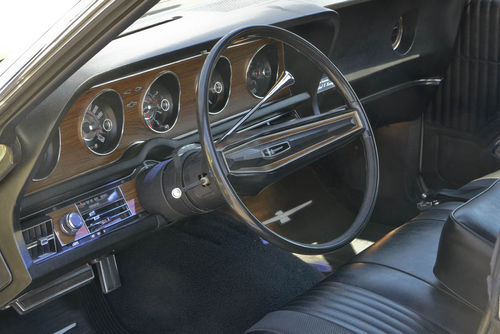
The quarter panels and the lower fenders are rust areas, as are the door bottoms if the drain holes are blocked, but Murray warned of potential damage caused by the Power Ventilation with its opening below the backlight.
“The drains go down through the trunk floor,” he explained. “From the back window, they come right straight down. They’re up towards the rear seat on each side of the spare tire, they’re rubber and of course, they would deteriorate, so you have to be careful with that because otherwise, it would drain, but it drains into your trunk. And you know, if left undone, what that would do to the floor of the trunk.”
Changing the drains on his car wasn’t a major undertaking, nor was replacing air conditioning components.
“The compressor for the air conditioning was noisy last year,” Murray said, “and I was able to buy a brandnew compressor for it, not one of the aftermarket deals. It was just like the original. The condenser, I had to change that, too, at one point.”
Most of the mechanical parts are readily available since so many are shared with other Ford products, but the same can’t be said for sheet metal, trim and interior components.
“One thing that is, I feel, a little bit of a problem with the ’67s through ’71s is that you don’t find a lot of people who have parts for them,” Murray said. “And let’s face it. You have to question whether anybody will start reproducing because how many—especially of the fourdoors—are there?”
He said body parts show up only rarely and new old stock or reproduction trim is virtually nonexistent, two points emphasizing the need to start with the best and most complete example possible. There is, however, at least one bright spot in that some of the interior equipment isn’t Thunderbird-specific. He gave the example of the switches for the power windows that were also used on contemporary Lincolns as well as the dashboard equipment that might have Thunderbird knobs or faceplates on Ford parts.
If parts were available, he said, the actual restoration of a car like his probably would not be as difficult as it might seem.
“After doing my ’66 Lincoln,” he said, “this would be a walk in the park.”
His other Thunderbirds that are similar to the feature car are all lowmileage originals and didn’t require restorations. He pulled the engine on the 1970 to clean and detail it, but that was the extent of its disassembly and completely straightforward. Since it now shows just 30,000 miles, it probably will be a long time before major work is necessary, but simple math shows that Murray’s driven it only about 4000 miles despite his having owned it far longer than its first owner had it.
Driving it, though, isn’t the only way to appreciate it and he knows that 34 years later, his Thunderbird remains as appealing to him as ever.
“Yes, sure it is,” he said, “and I still catch myself at times going out into the garage and just looking at it. Yeah, it’s 34 years later and somebody’ll say to me ‘well, would you sell it?’ I say ‘no. I wouldn’t even consider it.’”
Does that make it his favorite car?
“It’s like kids,” he observed. “You might have a favorite in your heart, but you don’t tell anybody.”

